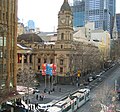Joseph Reed (architect)
Joseph Reed | |
|---|---|
 | |
| Born | 1823 Cornwall, England |
| Died | 29 April 1890 Melbourne, Victoria |
| Nationality | British |
| Occupation | Architect |
| Buildings | State Library of Victoria, St Michael's Uniting Church |
| Projects | Royal Exhibition Building |
Joseph Reed (c. 1823–1890), a Cornishman by birth, was probably the most influential Victorian era architect in Melbourne, Australia.[1] He established a practice, Reed and Barnes in Melbourne in 1862. The practice now known as Bates Smart is one of the oldest continually operating in the world.
Biography
Probably born in 1823 in Cornwall, England, Joseph Read arrived in Melbourne in 1853. The following year he won a design competition for the State Library of Victoria, designed the Bank of New South Wales in Collins Street and the Geelong Town Hall. In 1862 he partnered with Frederick Barnes (1824-1884).[2]
Following a visit to Europe in 1863 he was impressed by the brick architecture of Lombardy, an influence visible in the designs for the Independent Church on Collins Street, St Jude's in Carlton, the National school in Carlton, and in the Frederick T. Sargood's Rippon Lea Estate at Elsternwick. His architecture remained however eclectic, including Italianate, Classic, Gothic and Scottish baronial.[2]
In 1883 Barnes retired from the partnership and Reed was joined by A. M. Henderson and F. J. Smart. In 1890 Henderson withdrew while N. B. Taplin joined the firm. The office later became Bates, Peebles and Smart.[2]
In 1890 Reed came into financial difficulties, and died of "inanition and exhaustion", on 29 April.[2]
Architectural expression
Reed's buildings represent an impressive body of work much of which still exists today. They include the classical State Library of Victoria (1856), Collins Street Independent Church (1867), Frederick Sargood's Rippon Lea Estate (1868) and Melbourne Trades Hall (1873). In contrast to the polychrome Romanesque of Rippon Lea and the Independent Church is the stern Gothic manner of Scots' Church (1871-4) across the road; the energetic spire was for the last decades of the nineteenth century Melbourne's tallest structure. The Trades Hall is grandly palatial, the world's oldest and probably most splendid trades hall. In the fashionable Second Empire style Reed also designed Melbourne Town Hall (1870); the World Heritage-listed Royal Exhibition Building, completed for the 1880 International Exposition in Melbourne; and the now demolished Menzies Hotel (1867). Reed completed the building of St Paul's Anglican Cathedral to the designs of William Butterfield after that architect resigned the project in 1887. Reed was faithful to the original design, but provided most of the furnishings, including the elaborate pulpit.
List of works
- State Library of Victoria (1854)
- Collins Street Baptist Church (1854)
- Geelong Town Hall (1855)
- Bank of New South Wales, Collins St (1856)
- Wesley Church (1857)
- 182-186 George Street, East Melbourne (1857)
- Frogmore House, Carnegie (c.1857)
- Royal Society Buildings (1858)
- 157 Hotham Street, East Melbourne (1861) (attributed)
- Reed & Barnes
- Commercial Banking Company of Sydney (1862) (demolished 1956)
- St Michaels Uniting Church (1866)
- The Menzies Hotel (1867)
- Rippon Lea Estate (1868)
- Melbourne Town Hall (1869)
- Carlton Methodist Mission, now Church of All Nations, Palmerston St, Carlton (1870)
- Jewellery manufactory at the rear of 15 Little Collins St West for David Rosenthal & Co. (1872)
- Melbourne Trades Hall (1873)
- Scots' Church (1873)
- ANZ Bank, Collins Street (1876)
- Faraday School, Carlton (1876)
- Academy of Music, Bourke St East (1876). Renamed Bijou Theatre 1880. Burnt down 1889.
- Eildon Mansion (1877)
- Eastern Market (1877) (Reed & Barnes) (demolished in the 1960s)
- Wilson Hall, Melbourne University (destroyed by fire in 1952)
- Royal Exhibition Building (1879)
- Ormond College, Melbourne University (1881)
- Holy Trinity Church, St Kilda (1882–1889)
- Reed, Henderson & Smart
- Old Pathology Building, Melbourne University (1885)
- Redcourt Estate (Armadale) (1887)
- Lombard Building (15-17 Queen Street) (1887)
- Baldwin Spencer Building, Melbourne University (1887)
- Old Physics Conference Room and Gallery, Melbourne University (1888)
- Sacred Heart Church, St Kilda (1891)
- A.C Goode House (Wright, Reed & Beaver) (1891)
- Reed, Smart & Tappin
- Mutual Store, Flinders Street (1891)
- Metropolitan Gas Company (1892)
- Church of Our Lady of the Sacred Heart, Carlton (1910)
Gallery
-
State Library of Victoria. Swanston Street, Melbourne
-
Former Bank of New South Wales. Transplanted from Collins Street to the University of Melbourne Union Lawn
-
Collins Street Baptist Church
-
Geelong Town Hall
-
Melbourne Trades Hall, Carlton
-
The Scots' Church. Collins Street, Melbourne.
-
157 Hotham Street, East Melbourne.
-
Rippon Lea Estate. Elsternwick, Victoria.
-
Melbourne Town Hall, Collins Street
-
The Royal Exhibition Building, Carlton
-
St Paul's Cathedral, Flinders Street
-
Wesley Church, Melbourne
-
Eildon Mansion
-
Ormond College Clock Tower, University of Melbourne
-
Former Metropolitan Gas Company building on Flinders Street, Melbourne
-
Holy Trinity Church, St Kilda
-
Sacred Heart Church, St Kilda
-
Lombard Building
-
A.C Goode House
-
Former Mutual Store
-
Redcourt Estate, Armadale
References
- ^ Dunstan, David: "Joseph Reed: A city’s greatest architect", in Australian Heritage, Autumn 2010
- ^ a b c d Saunders, David. "Reed, Joseph (1823? - 1890)". Australian Dictionary of Biography Online. Australian National University. Retrieved 23 September 2012.
External links
- Saunders, David. "Reed, Joseph (1823? - 1890)". Australian Dictionary of Biography Online. Australian National University. Retrieved 16 January 2011.




















